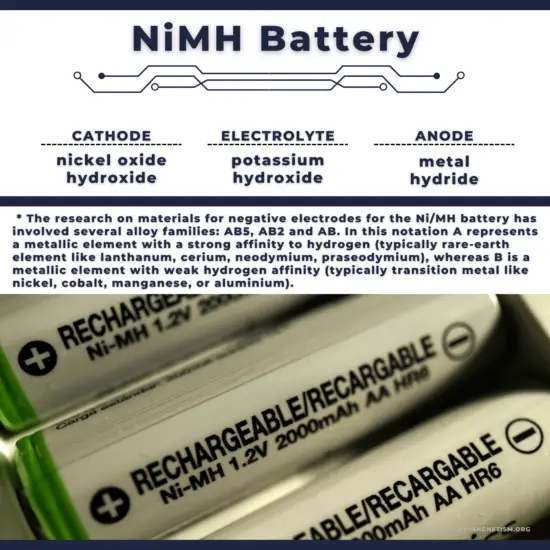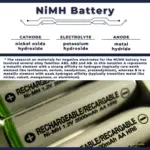Nickel Metal Hydride Battery

A nickel metal hydride battery, NiMH, is a rechargeable battery with a positive electrode made of nickel hydroxide and a negative electrode made of a metal hydride (a hydrogen-absorbing alloy). The NiMH battery was commercially introduced in 1989 and was mainly used as a power source in portable personal computers. Since then, the NiMH battery system has become very popular in electric hybrid vehicles and makes up 10% of the total market for rechargeable batteries. Compared to the NiCd battery, the NiMH provides 40 percent higher specific energy resulting in about two times higher capacity. NiMH batteries are also less affected by voltage depression, but the main advantage is the absence of toxic cadmium. The memory effect of NiMH batteries is much less than nickel-cadmium batteries.
Compared to alkaline batteries, the internal resistance of NiMH batteries is much lower. Because of this, they have the advantage that a higher voltage can be maintained under high load.
With high specific energy (up to 100Wh/kg) and energy density (double of lead-acid and 40% more than nickel-cadmium), high cycle life, low cost, recyclability (cadmium is hazardous), and other qualities made it the most used battery and still nowadays is one of the most used. Its applications are much diverse: battery cells AA or AAA, cameras, old mobile phones, electric razors, medical instruments and equipment, and high-power static applications. Compared to the lead-acid battery, the drawback is that it is more expensive than lead acid per kWh.
NiMH batteries are (re)charged by applying electric current, which reverses the chemical reactions that occur during discharge/use. Devices to supply the appropriate current are called chargers. The electronics in charging systems and control circuits for NiMHs are simple and inexpensive, and the battery is considered safe. The NiMH battery also has high self-discharge and can lose up to 20 % of its charge during the first 24 hours and thereafter 10 % per month.
Like NiCd batteries, they have a nominal voltage of 1.2V per cell with a typical end-of-discharge voltage of 1V.
The total voltage of the redox reaction is E0 = 0.49V – ( – 0.83V) = 1.32V.
Nevertheless, they are widely used as a replacement for alkaline batteries, which have 1.5V nominal voltage per cell, in many applications and are commonly found in standard battery designs. In some applications, however, the lower nominal voltage can be a disadvantage. For example, unregulated lights that are designed for 1.5V operation tend to shine less brightly.
Characteristics of Nickel Metal Hydride Batteries
To compare and understand the capability of each battery, some important parameters are characteristic of each battery, also within a type of battery. These parameters are a reference when a battery is needed, and specific qualities are required since batteries are used in all types of devices and for infinite purposes.
Cell Voltage
The voltage of electric batteries is created by the potential difference of the materials that compose the positive and negative electrodes in the electrochemical reaction.
A common open circuit voltage for NiMH batteries (e.g. AAA and AA) is 1.2V.
Cut-off Voltage
The cut-off voltage is the minimum allowable voltage. It is this voltage that generally defines the “empty” state of the battery.
When testing the capacity of a NiMH or NiCd battery, a cut-off voltage of 1.0 V per cell is normally used, whereas 0.9 V is normally used as the cut-off voltage of an alkaline cell.
Capacity
The coulometric capacity is the total Amp-hours available when the battery is discharged at a certain discharge current from 100% SOC to the cut-off voltage.
NiMH AA batteries feature a nominal voltage of 1.2 volts and an average capacity of 2000-2700 mAh.
C-rate of Battery
C-rate is used to express how fast a battery is discharged or charged relative to its maximum capacity. It has units h−1. A 1C rate means that the discharge current will discharge the entire battery in 1 hour.
Typically, high C-rate NiMH batteries can be charged at 1C and be fully charged in just over an hour.
Self-discharge
Batteries gradually self-discharge even if not connected and delivering current. This is due to non-current-producing “side” chemical reactions that occur within the cell even when no load is applied.
The NiMH battery also has high self-discharge and can lose up to 20 % of its charge during the first 24 hours and thereafter 10 % per month.
Degradation
Some degradation of rechargeable batteries occurs on each charge-discharge cycle. Degradation usually occurs because electrolyte migrates away from the electrodes or because active material detaches from the electrodes.
The cycle life for NiMH batteries is typically 700-1,000 life cycles.
Depth of Discharge
Depth of discharge is a measure of how much energy has been withdrawn from a battery and is expressed as a percentage of full capacity. For example, a 100 Ah battery from which 40 Ah has been withdrawn has undergone a 40% depth of discharge (DOD).










